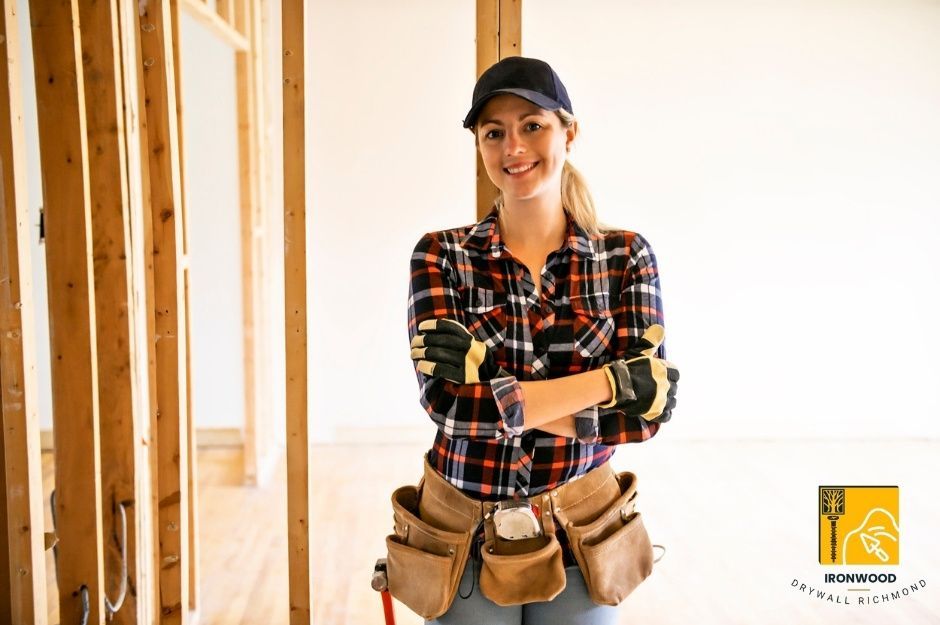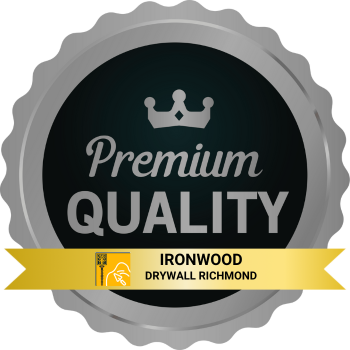Pitt Meadows Drywall Repair
Drywall Repair Company in Pitt Meadows, BC

When your walls need professional attention in Pitt Meadows, you'll find skilled drywall contractors at Ironwood Drywall Richmond ready to tackle any repair or installation project. Located in the Lower Fraser Valley with a population of 19,498 as of 2024, Pitt Meadows presents unique challenges for drywall contractors due to its oceanic climate and flood-prone geography. From minor crack repairs to complete installations, local experts bring years of experience in handling residential and commercial drywall services.

Ironwood Drywall Richmond

Your drywall needs in Pitt Meadows are covered by contractors who specialize in patching, crack repair, plaster restoration, popcorn ceiling fixes, and water damage remediation. These professionals use high-quality materials and proven techniques to ensure lasting results that maintain your property's value and appearance. Given that 68% of Pitt Meadows lies within a floodplain and is protected by 64 kilometres of dikes, local contractors have developed specialized expertise in moisture-related drywall issues.
Pitt Meadows contractors offer comprehensive drywall finishing services to complete your project with precision. Whether you require texture blending, smooth finishes, or detailed finishing work, local specialists can transform your walls and ceilings into flawless surfaces that enhance your space's aesthetic appeal. Many contractors in the area also serve neighboring communities including Maple Ridge, Port Coquitlam, Coquitlam, Surrey, and Langley, bringing broader regional expertise to local projects.
Comprehensive Drywall Repair Services in Pitt Meadows
Professional drywall repair services in Pitt Meadows address common wall and ceiling damage through specialized techniques and high-quality materials. With the city's history dating back to 1914 as an agricultural community, many homes feature older construction methods that require specialized restoration techniques. Local contractors offer targeted solutions for various types of damage, from minor cracks to major water damage.
Drywall Patching and Crack Repair
Small holes and cracks in your drywall require prompt attention to prevent further deterioration. Professional contractors use mesh tape and joint compound to create seamless repairs for nail holes, door knob damage, and stress cracks. In Pitt Meadows' oceanic climate with cool, rainy winters and warm summers, seasonal temperature fluctuations can cause settling cracks that require expert attention.
For larger holes, contractors cut clean edges around the damaged area and install a new drywall piece. They secure it with drywall screws and apply multiple layers of joint compound.
The repair process includes:
- Initial damage assessment
- Surface preparation
- Patch installation
- Multi-layer compound application
- Sanding and texture matching
Plaster Repair and Restoration
Plaster walls require specialized repair techniques different from standard drywall methods. Many of Pitt Meadows' heritage buildings, including structures in the Heritage Preservation Area near the old General Store (now the Pitt Meadows Museum), feature original plaster that requires careful restoration to maintain historical integrity. Contractors first stabilize loose plaster using plaster washers or adhesive systems.
Your repair specialist will mix custom plaster compounds to match your existing wall texture and composition. This ensures consistent appearance and durability. Local contractors are particularly experienced with repairs needed in homes built during the post-World War II era when Dutch farmers reclaimed much of the low-lying land, as these properties often feature unique plaster applications.
Common plaster repairs include:
- Crack stabilization
- Surface reinforcement
- Historic restoration techniques
- Texture matching
- Base coat repairs
Drywall Water Damage Repair Solutions
Water-damaged drywall needs immediate attention to prevent mold growth and structural issues. Pitt Meadows' location at the junction of the Fraser and Pitt Rivers, combined with its position in a 200-year floodplain, makes water damage a particular concern for local property owners. Contractors first identify and eliminate the water source before beginning repairs.
The repair process starts with removing wet materials and drying the affected area thoroughly. Local contractors are well-versed in dealing with damage from both seasonal flooding and the high precipitation levels (averaging 1,649.1mm annually) that characterize the region. Professionals use moisture meters to ensure complete drying before installing new drywall.
Essential steps include:
- Moisture testing
- Damaged material removal
- Mold prevention treatment
- New drywall installation
- Texture matching and painting
Emergency water damage services are particularly important during flood seasons, with contractors maintaining 24/7 availability during high-risk periods when the Fraser River levels rise.
Popcorn Ceiling Repair Techniques
Popcorn ceiling repairs require careful attention to match existing textures. In homes built during Pitt Meadows' rapid growth period from 1976-1991 when the population increased by 138%, popcorn ceilings were commonly installed and now require specialized maintenance. Contractors first test the material for asbestos, particularly in homes built before 1980.
Professional repair techniques preserve the surrounding texture while addressing damaged areas. Your contractor will apply matching popcorn texture using specialized spray equipment.
Key repair steps involve:
- Damage assessment
- Surface preparation
- Texture matching
- Seamless blending
- Paint color matching
Expert Drywall Installation and Taping
Professional drywall installation and taping services in Pitt Meadows combine precision craftsmanship with high-quality materials to create smooth, durable walls that meet both residential and commercial building codes. With 82% of Pitt Meadows designated as Green Zone lands, contractors must be knowledgeable about environmental building standards and sustainable construction practices.
Residential and Commercial Drywall Installation
Your drywall installation begins with precise measurements and careful preparation of the workspace. In Pitt Meadows' challenging soil conditions, particularly in the northern sector's peat bog areas, contractors must account for potential settling and use specialized fastening techniques. Professional contractors use specialized tools to cut and place sheets accurately, minimizing waste and ensuring proper fit.
For residential spaces, 1/2-inch drywall is typically installed in living areas, while 5/8-inch fire-resistant drywall is used in garages and between units in multi-family buildings. Given the proximity to Pitt Meadows Regional Airport (opened in 1963), contractors also consider sound-dampening requirements for properties in flight paths.
Commercial installations require specific fire ratings and sound dampening properties. Contractors install Type X or Type C drywall for enhanced fire resistance in commercial buildings. Local contractors frequently work on agricultural facilities, given that 86% of Pitt Meadows lies within the BC Agricultural Land Reserve, requiring specialized knowledge of farm building codes.
Metal studs are often preferred in commercial settings, while wooden studs remain common in residential applications.
Specialized Drywall Taping Methods
Professional tapers apply three distinct coats of joint compound to achieve seamless walls. The first coat embeds the tape, the second builds up the joint, and the third creates a smooth finish. In Pitt Meadows' high-humidity environment, contractors adjust drying times and may use dehumidifiers to ensure proper curing between coats.
Common Taping Techniques:
- Paper tape for flat joints and corners
- Fiber mesh tape for high-stress areas
- Metal corner bead for external corners
- Wet sanding between coats for optimal smoothness
Specialized tools like automatic tapers and corner tools ensure consistent application and professional results.
Insulation Integration for Drywall
Proper insulation installation before drywall placement improves energy efficiency and sound control. Due to Pitt Meadows' oceanic climate with winter lows averaging 0.5°C in January and summer highs of 25.1°C in August, proper insulation is crucial for year-round comfort. R-13 to R-23 rated insulation is standard for exterior walls in Pitt Meadows' climate.
Insulation Types:
- Fiberglass batts
- Blown-in cellulose
- Spray foam options
Vapor barriers are installed on exterior walls to prevent moisture accumulation. Given the area's high annual precipitation of 252.4mm in January alone, contractors pay special attention to vapor barrier installation and sealing. Professional contractors ensure proper spacing between insulation and electrical boxes for safety compliance.
Air gaps are carefully sealed around outlets and fixtures to maintain the insulation's effectiveness.
Professional Drywall Finishing and Surface Preparation
Professional drywall finishing creates smooth, seamless walls through precise taping, mudding, and sanding techniques. Contractors in Pitt Meadows often work with the natural lighting conditions created by the area's mountain views, including the Golden Ears peaks to the north and the Thompson Mountain Range along the northeast edge. Each step builds toward a perfect surface ready for painting.
Finishing Techniques for Smooth Walls
The drywall finishing process starts with applying paper or mesh tape over joints and seams. A thin layer of joint compound covers the tape to create a base layer. Local contractors have adapted their techniques to account for the area's seasonal humidity variations, which can affect drying times and compound consistency.
Multiple coats of drywall mud are applied with each layer extending wider than the previous one. This feathering technique helps blend the repair area with surrounding wall surfaces.
Between coats, careful sanding removes ridges and imperfections. Use 120-grit sandpaper for initial smoothing, followed by 150 or 220-grit for final passes.
Preparing Drywall for Painting
Remove all dust with a vacuum and tack cloth before priming. In Pitt Meadows' dusty agricultural environment, contractors take extra care to seal work areas and use high-efficiency filtration systems. Inspect walls in bright lighting to spot any remaining flaws.
Fill small holes or divots with lightweight spackling compound. Sand these patches smooth once dry.
Apply a high-quality drywall primer to seal the surface and provide uniform absorption for paint. Choose a primer matched to your topcoat type. Given the proximity to waterways including Pitt Lake (the world's largest freshwater tidal lake), contractors often recommend moisture-resistant primers for optimal performance.
Interior Painting Coordination
Select paint sheens based on room function: flat finish for low-traffic areas, eggshell or satin for living spaces, semi-gloss for kitchens and bathrooms. Contractors in Pitt Meadows often recommend semi-gloss finishes for homes near the extensive dike system and waterways to provide better moisture resistance.
Test paint colors on primed drywall patches in different lighting conditions. Natural and artificial light can significantly affect how colors appear. The area's unique lighting conditions, influenced by reflections from Pitt Lake and the Fraser River, can impact color perception throughout the day.
Use premium roller covers and brushes suited for your paint type. Apply two coats of paint, allowing proper drying time between applications.
Pro tip: Paint within 48 hours of priming for optimal adhesion and a professional finish. In Pitt Meadows' variable weather conditions, contractors often use climate-controlled environments or adjust scheduling based on seasonal precipitation patterns to ensure optimal painting conditions.

